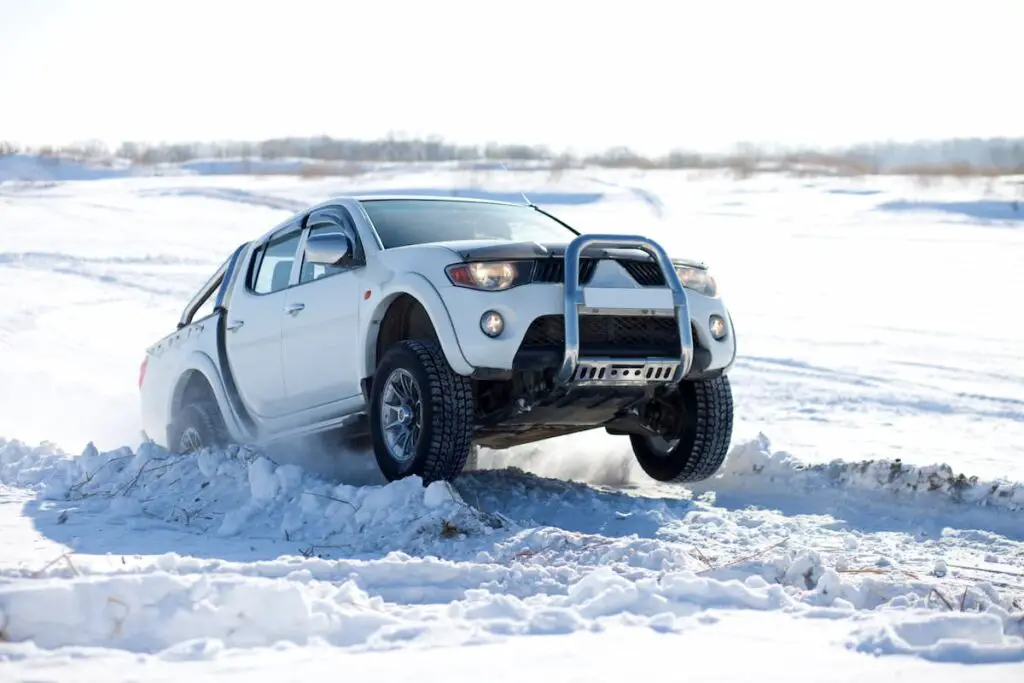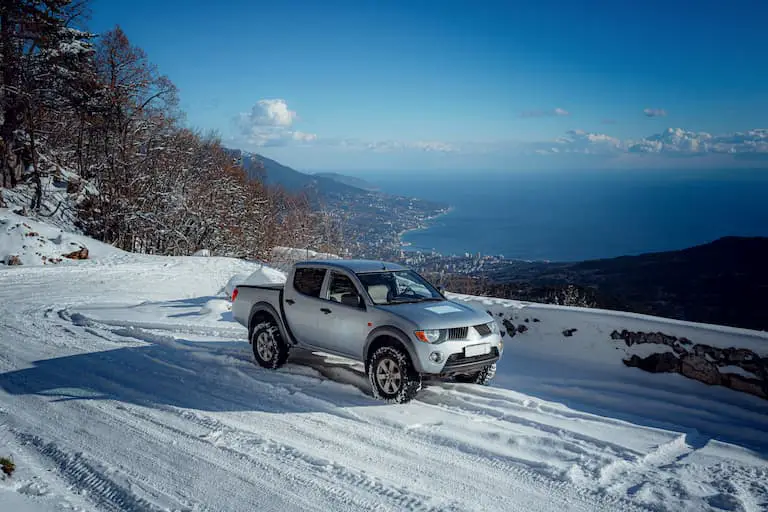As an Amazon Associate, we earn from qualifying purchases. We may also earn commissions if you purchase products from other retailers after clicking on a link from our site.
Driving in the snow isn’t a fun prospect for most people. After all, nobody wants to slip and slide across a snow-covered road. Many people say that a heavier car is safer and handles better when driving in snow, but is that necessarily true?
A heavy car is better in snow for traction, but the additional mass makes it harder to stop and steer. Cars with higher ground clearance drive better in the snow, but a higher center of gravity decreases stability. Ultimately, the car’s weight is less important than the condition of the tires.
Whether you’re planning a skiing trip and want to take the heavier car or planning to move to an area that receives significant snow, you want to drive safely. Read on to find out why weight is only one consideration.

What Advantages Do Heavier Cars Have in Snow?
The most significant advantage that heavier cars have in snow is increased traction. The additional weight pushes the tire into the snow, which gives the vehicle more traction.
Improved traction transfers more of the motor’s energy to the road, and the extra power means the vehicle can get going faster and is less likely to be spinning its wheels.
In a collision, a heavier vehicle will be safer than a light one. Also, they tend to be higher off the ground, giving them more clearance.
However, heavy cars with a high center of gravity, such as SUVs, have a higher risk of rolling over.
What Advantages Do Lighter Cars Offer?
One advantage lighter cars have is that they weigh less, so stopping them can be easier. Also, because the cars are lighter, drivers tend to be more careful traveling on snow-covered roads.
Furthermore, because of their weight, lighter cars are less likely to lose rear-wheel traction in a curve.
However, lighter cars typically have less clearance, so they can’t handle deep snow. And ironically, because they have less traction, it is easier for a light vehicle to get stuck in the snow.
Design and Price Make a Difference
Researchers at the University of Michigan and Lawrence Berkeley National Laboratory have determined that weight is only one safety consideration. Several things are more important than weight, including:
- Vehicle quality: By one measure, a lighter car has a higher death rate than heavier ones. But less expensive vehicles, light or heavy, also increase death rates.
- The type of drivers: Careful drivers who have experience in snow and icy road conditions will have fewer accidents, regardless of the car’s weight.
- Road conditions: Variables in road conditions are challenging to measure because they include the overall weather and differences in commute. For example, a driver who commutes at night on roads with lots of black ice is more likely to have an accident.
Because of these other considerations, these same researchers argue that the debate about weight and driving in the snow is misguided. Marc Ross, one of the researchers, says, “We need to […] move away from the idea that bigger and heavier vehicles are automatically safer.”

The Key to Driving and Stopping Safely Is Tires
From a physics perspective, tires are the critical variable. A tire pressed more into the ground by a heavier automobile will have more friction. But the increased inertia makes it harder to keep the friction, so the forces equalize.
Or, to put it less scientifically: your vehicle’s tires make contact with the road surface, not the brakes, drives, or safety features. Therefore, these features can only use the traction supplied by your tires. Consequently, it would help if you had tires with traction designed for winter driving—whether your car is heavy or light.
Don’t be fooled by “all-season” tires. In temperatures above 45 degrees, their rubber compounds function fine. But once temperatures drop below that, they harden. This causes driving in them to become unsafe as the temperature drops, regardless of the amount of moisture on the road.
Winter tires provide a better grip on cold roads thanks to the rubber compounds and their tread design. In addition, the rubber in winter tires remains flexible, allowing them to better grip the road than all-season tires.
Where the Weight Is Located Is Important
Another often overlooked part is the relationship between your car’s weight and the drive wheels. A vehicle should have its weight relatively balanced, with more weight over the wheels connected to your car’s drive train.
This especially applies to modern pick-ups, which were designed so the weight of items being hauled would create balanced handling. However, many drivers regularly drive with empty beds. This creates an imbalance that reduces rear-wheel traction.
Therefore, it is recommended that pick-up drivers put additional weight on the truck’s bed. How much weight depends on your truck, but you should never go above the truck’s maximum payload. Start a ½-ton (1000 kg) pick-up with 240 pounds (108.8 kg) and a 3/4-ton (680.38 kg) with 300 pounds (136.07 kg), and add more until the truck handles well.
These are some suggested items to place in the bed:
- Tube-shaped sandbags
- Drainage gravel
- Cat litter
- Potting soil
- Rock salt
The advantage of those items over fifth-wheel hitches or full gas tanks is they have multiple uses, including to help you out if you get stuck in the snow.
Tips for Driving Safely in the Snow
Driving safely in the snow is not simply about having anti-lock brakes, stability systems, and snow tires. You can have the best safety equipment, but they won’t do much good if you don’t drive safely.

If you start slipping on ice, do the following:
- Avoid slamming on the brakes or overcorrecting.
- Gradually drive in the direction of the skid
- After your car has traction, apply the gas.
Tip: If you get trapped in snow, don’t just step on the gas to power your car out. Instead, place something flat under the front of your tires, such as cardboard or the car’s floor mats. Then attempt to drive out of the rut slowly.
In other words, safety equipment doesn’t replace common sense.
Bottom Line
As you can see, there is no simple answer to the impact weight has on navigating snow- or ice-covered roads. Although weight is an important factor, tire quality is far more critical. Any vehicle—heavy or light—needs good winter tires to navigate the roads in areas that receive frequent snowstorms.
